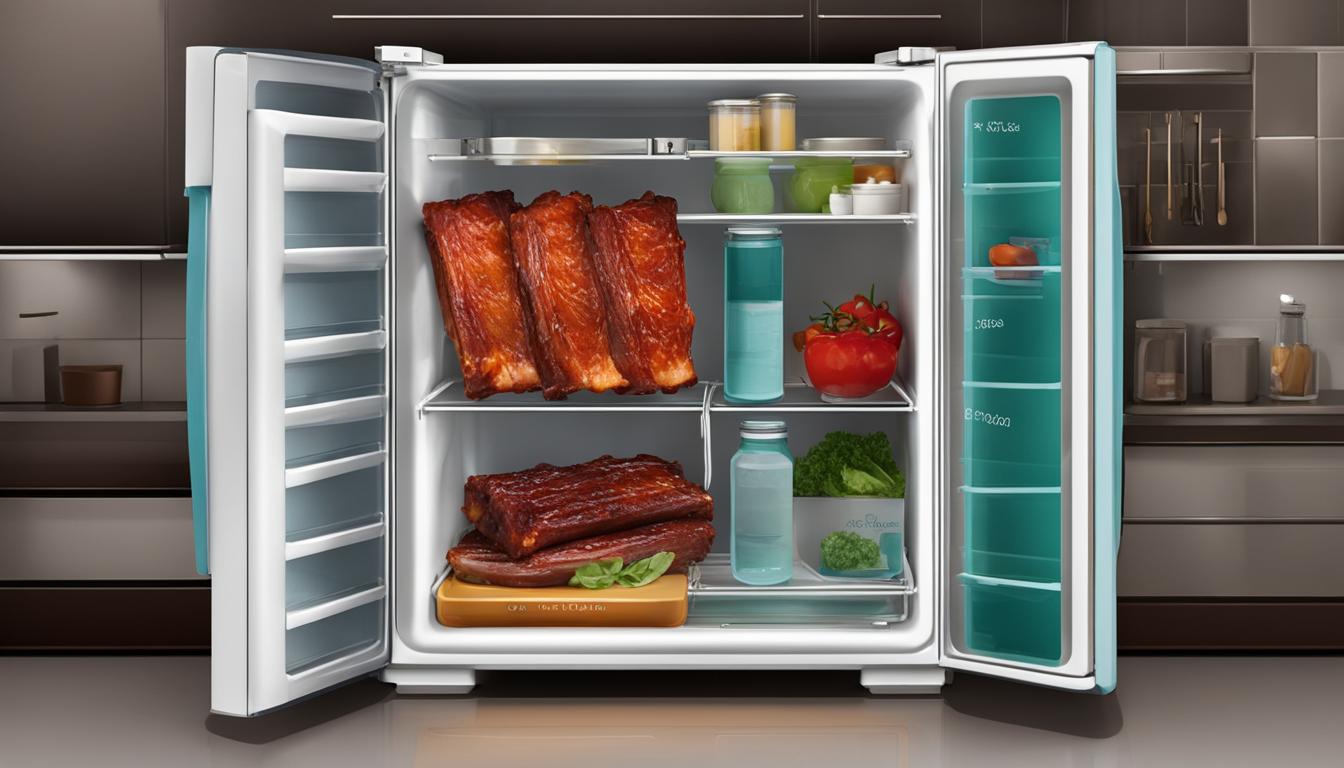As someone who thoroughly enjoys the art of barbecuing, I often face the question: “How Long Do Ribs Last in the Fridge?” Whether I’m handling succulent cooked ribs, fresh raw ribs straight from the butcher, or those I’ve stashed in the freezer for a rainy day barbecue, understanding the storage dynamics is essential.
The United States Department of Agriculture (USDA) provides a clear directive on these matters, suggesting that raw pork ribs should be cooked or frozen within five days to ensure freshness, and this timeline is slightly shorter for cooked ribs, which have a recommended fridge life of four days when kept at an optimal temperature below 40°F.
For barbecue enthusiasts who appreciate the intricacies of flavor preservation, freezing appears as a wise choice for extending the culinary life of your favorite ribs. Stored in the subzero sanctuary, raw ribs can maintain their quality for around six months, while cooked ribs boast a flavorful safety net of three months.
And while these timeframes mark the boundaries of peak tastiness, safety extends beyond when ribs are properly sealed against the icy elements. Understanding these guidelines is key to ensuring that every cut of meat achieves its highest potential on your plate.
Join me as I explore the depths of rib preservation and offer professional insights gleaned from both USDA recommendations and my personal journey in the realm of rib refrigeration.
- Raw ribs last up to five days in the fridge, while cooked ribs are good for four days if stored at below 40°F.
- Freezing is a viable method to preserve ribs, with raw ribs lasting about six months and cooked ribs three months.
- Proper sealing is crucial for both refrigeration and freezing to maintain the ribs’ freshness and prevent spoilage.
- Adhering to the USDA’s guidelines ensures both the safety and quality of the ribs you’re eager to enjoy.
- Temperature control is pivotal in the storage process, and the optimal fridge temperature for ribs is below 40°F.
- Always assess your ribs for any signs of spoilage such as changes in color, texture, and smell before consumption.
Introduction to Ribs Shelf Life
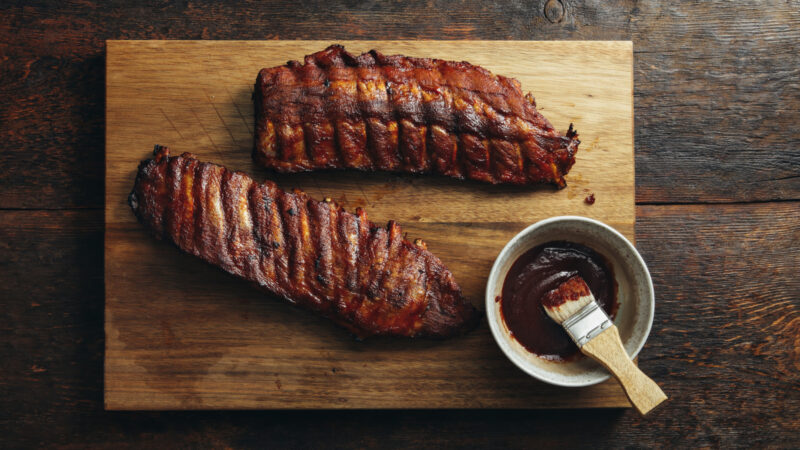
As an aficionado of all things barbecued, I find a profound sense of fulfillment in unraveling the mysteries of Rib Shelf Life. Whether I’m tending to a batch of raw ribs or minding some succulent smoked ones, understanding the time constraints within which these delicacies operate is crucial.
I adhere to the USDA’s guidelines, which underscore the nexus of Ribs Preservation and food safety. Developing an appreciation for the nuances of Ribs Refrigeration feels almost as important as mastering the smoker or grill.
To confer the depth of intricacy that Rib Preservation demands, it’s essential to recognize what happens within the confines of our refrigerators. Here lies the fine line between peak taste and potential waste—where attention to detail could mean the difference between a rib feast and a dated defeat.
Preserving the freshness of ribs in the fridge revolves around diligent storage at a temperature set steadfastly below 40°F, which curbs the unwelcome proliferation of spoilage bacteria.
Let’s break down the specifics and shed some light on how best to maintain your ribs, whether you’re planning to feast in a day or savor the flavors sometime down the road. Here’s what my experience, paired with USDA advice, suggests about the longevity of ribs in the refrigerated world.
| Type of Ribs | Refrigerator Shelf Life | Optimal Storage Conditions |
|---|---|---|
| Raw Pork Ribs | Up to 5 days | Sealed, |
| Cooked Pork Ribs | 3 to 4 days | Airtight, |
| Raw Beef Ribs | 3 to 5 days | Vacuum-sealed, |
| Cooked Beef Ribs | Up to 4 days | Minimal Oxygen Exposure, |
Remember, these numbers assume that your ribs have never entered the bacterial “danger zone” of 40–140°F after purchase. Depending on how your ribs are wrapped, whether they’re raw or cooked, and the precise temperature of your fridge, slight variations may apply.
Striking the fine balance not only preserves the glorious taste we all cherish but it aligns with a sustainable approach against the backdrop of modern-day food consumption.
Basics of Rib Refrigeration
As a seasoned grill master, I’ve learned that the secret to unforgettable ribs is not just in the cooking process, but also in mastering Rib Preservation. A deep dive into Rib Refrigeration allows us to understand that the prime directive here is to prevent our prized ribs from entering the bacterial ‘danger zone’, which is anywhere from 40 to 140°F.
Keeping ribs stored correctly below 40°F is fundamental to safeguarding their succulent flavor and texture. This form of preservation plays a pivotal role in how I serve ribs that are consistently safe, fresh, and delectably tender.
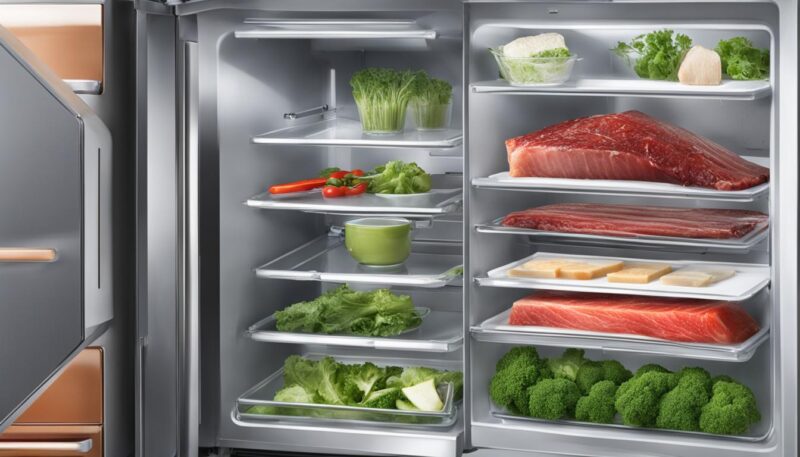
Adherence to Rib Storage Guidelines not only is about temperature regulation; it’s equally about choosing the right containment. Proper packaging is a must to seal the deal on freshness — quite literally.
Ensuring ribs are well-encased in airtight packaging thwarts the spoiling efforts of any refrigerator-bound bacteria. Whether you prefer saucy baby backs or meaty St. Louis cuts, meticulous refrigeration safeguards your culinary investment until the moment you’re ready to feast.
By sustaining ribs in their optimal state within the confines of our chilly appliance, we establish a safeguard against premature spoilage while endorsing an ethos of responsible food perseverance.
Let’s scrutinize the best approaches and tools necessary for executing top-notch Rib Preservation in a refrigerated setting:
- Airtight Sealing: Utilize cling wrap, foil, or vacuum-sealed bags to create an environment deprived of oxygen — bacteria’s ally in the spoilage war.
- Refrigeration: Never let ribs linger at room temperature. Promptly refrigerate after purchase or cooking.
- Maximizing Freshness: Purchase ribs from reputable sources to ensure the cut’s initial quality, which can directly influence its longevity post-purchase.
While our focus hovers around ribs, these principles aren’t just limited to pork. Beef ribs and assorted rib cuts benefit equally from such stringent Rib Refrigeration strategies.
With these practices, I go to rest easy at night, knowing that the ribs chilling in my fridge are in their safest haven, ready to deliver an explosive flavor at my next barbecue gathering.
Proper Storage Techniques for Raw Ribs
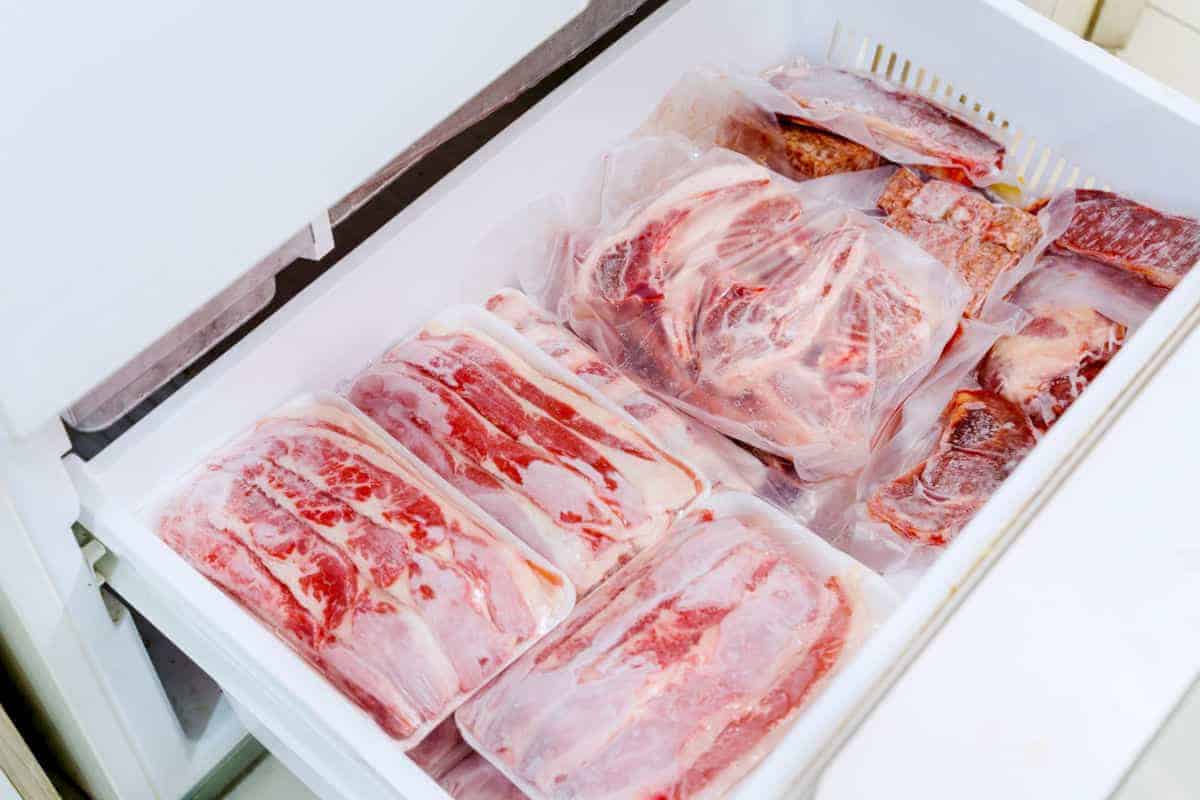
The conservation of raw ribs must never be left to chance. My approach is methodical; I store them in airtight containers or bags to seal off any avenues for airborne bacteria. Here, Proper Storage Techniques are not merely advised; they are non-negotiable for ensuring raw ribs last.
Guided by my expertise and USDA guidance, I place these packaged ribs on the lower shelves of the refrigerator, shielding them from the inconsistency of temperature that the door area is subjected to.
If the ribs are housed in their original vacuum-sealed packaging, they hold a fortress against time, typically 3-5 days past the sell-by date. However, one must acknowledge that the splendor of ribs is best relished when fresher.
| Factor | Check | Outcome |
|---|---|---|
| Freshness Indicator | Sell-By Date | Determines baseline of freshness |
| Visual Assessment | Color of Meat and Fat | Indicates Meat Quality |
| Storage Solution | Airtight Container or Bag | Extends freshness post Sell-By Date |
| Placement | Lower Refrigerator Shelves | Leverages cold and stable temperature |
It is not about merely extending the time wherein raw ribs can be deemed safe to consume; the mission is to sustain their inherently rich flavors and textures so they may serve as the centerpiece of a memorable meal.
The assurance of raw rib preservation within our domestic chillers is pivotal in my practice. By adhering to these methods, we’re not just storing meat; we’re setting the stage for the future culinary alchemy that is barbecue.
Rib Freezing Fundamentals: Extending Shelf Life
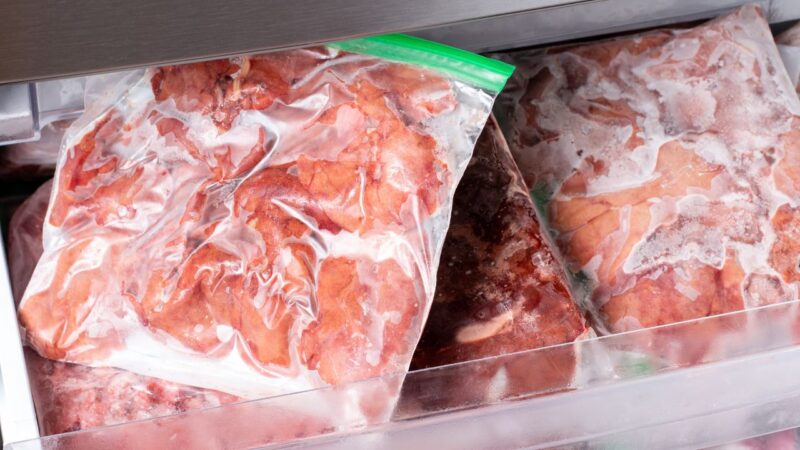
As a diligent home cook and barbecue enthusiast, I often find myself with more ribs than can immediately be enjoyed. It’s vital to understand the art of Rib Freezing for those occasions.
Freezing not only halts the growth of spoilage bacteria but also extends the enjoyment of your lovingly prepared ribs. Here, I impart my go-to strategies for freezing both raw and cooked ribs, ensuring safety and flavor are locked in for future feasting.
Freezing Raw Ribs: Steps for Long-Term Preservation
When I’m met with the fortunate dilemma of excess raw ribs, I take particular steps to ensure they are prepared for Freezing Raw Ribs properly. It begins by tightly wrapping them in heavy-duty aluminum foil or freezer paper, an essential step that wards off freezer burn.
Alternatively, placing ribs in heavy-duty freezer bags can be just as effective. The goal is not just about Extending Shelf Life, but maintaining taste and texture as well, ideally within a window of 4 to 6 months.
| Material | Benefit |
|---|---|
| Heavy-Duty Aluminum Foil | Prevents freezer burn, retains moisture |
| Freezer Paper | Protects flavor, provides barrier against cold air |
| Heavy-Duty Freezer Bags | Seals out air, easy to label and store |
Best Practices for Freezing Cooked Ribs
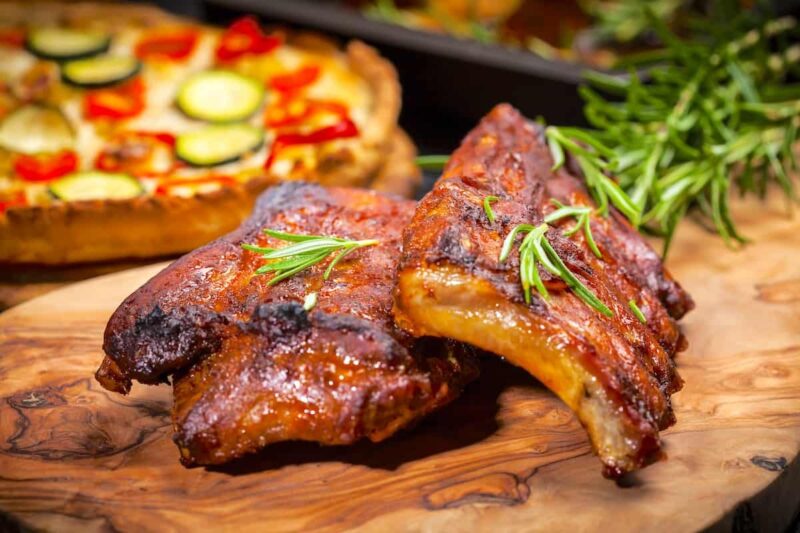
When preserving the succulent flavors of cooked ribs, I swear by a double protection approach to battle against the icy elements. This involves an initial wrap in heavy-duty aluminum foil, followed by a vacuum-sealing process that ensures no moisture is lost to the unforgiving frost.
This meticulous practice allows Best Practices Freezing cooked ribs which can extend their peak quality for two to three months in a freezer set to a stalwart 0°F. Beyond this period, while their safety endures, it is wise to consume them to savor the fullness of their flavors.
Thawing Methods for Frozen Ribs: Ensuring Safety and Flavor
The process of thawing is just as critical as freezing. To guarantee safety and preserve the mouth-watering flavors, I advocate for a refrigerated thaw. This slow return to pliability allows ribs the grace to maintain their structural integrity, with an option to refreeze if necessary.
This stands as one of the safest Thawing Methods Frozen Ribs can undergo, being sure to avoid room temperature or hot water techniques that may invite bacterial growth.
Should time be pressing, I occasionally resort to cold water or microwave methods but then, they must proceed immediately to the heat of cooking or reheating. It’s this careful attention to thawing that ensures ribs emerge as tantalizing and flavorful as the day they were first prepared.
It’s about careful planning and execution: from wrapping to freezing to thawing, each step assures not just extended storage, but the promise of flavor and safety at your next barbecue.
- To thaw, shift ribs from the freezer to the refrigerator a day prior to ensure a gradual defrost.
- Avoid compromising safety with room temperature thawing.
- After a cold water or microwave thaw, cooking or reheating should be immediate.
In my kitchen, these pillars of Rib Freezing serve as the backbone for the successful preservation of both raw and cooked ribs. It is through such practiced precision that we can ensure an extension of enjoyment, taking what could have been an ephemeral pleasure and granting it a cherished longevity within our culinary experiences.
How to Tell if Ribs Have Spoiled
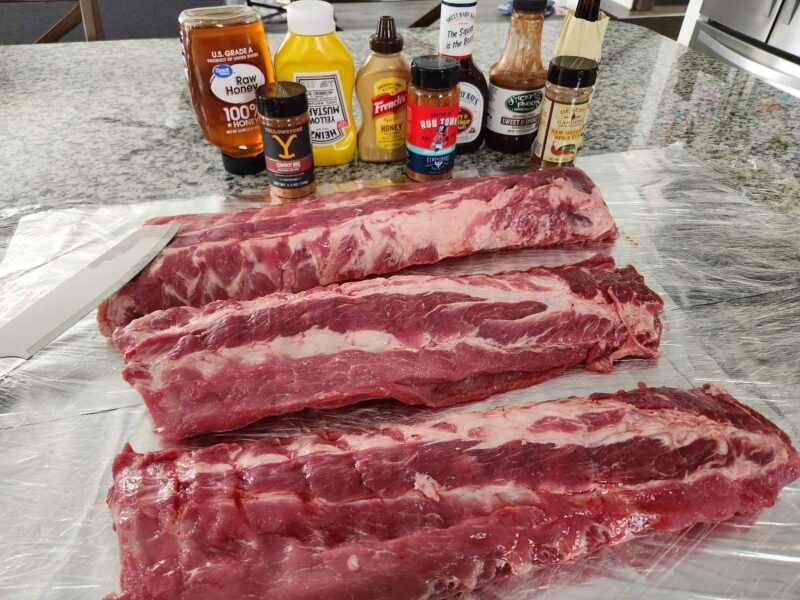
For any barbecue enthusiast, there’s a particular disappointment that accompanies discovering your ribs have turned bad. My heart sinks at the thought of those beautifully marbled cuts going to waste.
Being proficient in discerning the signs of spoilage is crucial so that we can prevent consumption of meat that may pose health risks. Recognizing these indicators can protect you and your guests from potential foodborne illnesses. Let’s explore the unmistakable signs that signal it’s time to discard those ribs.
One of the first things I do when checking ribs for spoilage is to look closely at the coloration of the meat. If the vibrant pink or red has turned to an unwelcoming greenish-gray or brown, I consider this a red flag. I also rely heavily on my sense of smell.
An optimal rib will have a fresh, meaty scent, perhaps with a hint of smokiness if they are cooked. The presence of a sour or ammonia-like odor is an immediate indication that the ribs should not be consumed.
The feel of the meat is also a telling factor. Fresh ribs should be moist but not emit a sticky residue. A slimy or unusually mushy texture is indicative of bacterial presence, a direct passport to the bin. It’s these sensory examinations that have served me well in my years of barbecue practice.
Ribs Storage Tips: Expert Advice for Rib Lovers
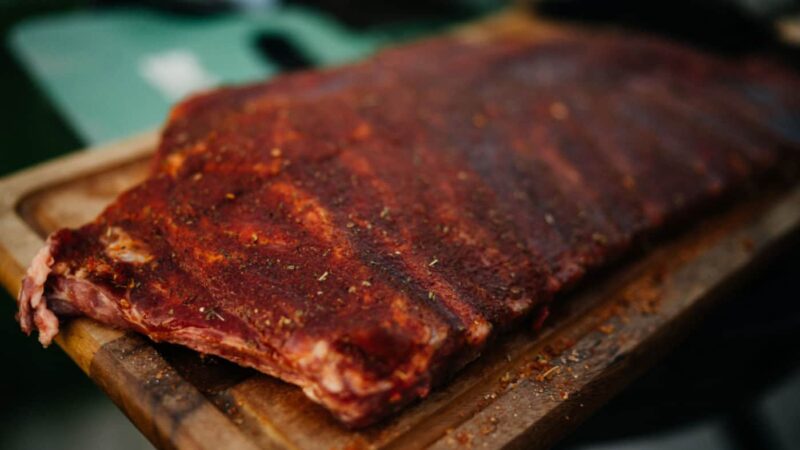
As a connoisseur of mouthwatering barbecue, I’ve come to learn that the journey to a perfect rib feast doesn’t end at the grill. Proper storage plays a crucial role in maintaining the taste, tenderness, and safety of your ribs, whether they’re ready to be savored or waiting for their moment of smoky glory.
Here are my personal go-to Ribs Storage Tips, focusing on Choosing Containers and Wrapping Materials, and how to execute Strategic Fridge Organization to ensure your ribs remain as irresistible as when they first left the smoker or the store.
Choosing Containers and Wrapping Materials
When the time comes to stow away your ribs, giving due consideration to the vessels and materials they’re stored in can mean the difference between a delectable repeat performance and a date with disappointment.
Selecting airtight containers is the first step I take, ensuring that no unwelcome air can tamper with the ribs’ integrity. Serious rib aficionados might want to invest in vacuum-sealing equipment, which can substantially extend your ribs’ shelf life.
Strategic Fridge Organization for Rib Storage
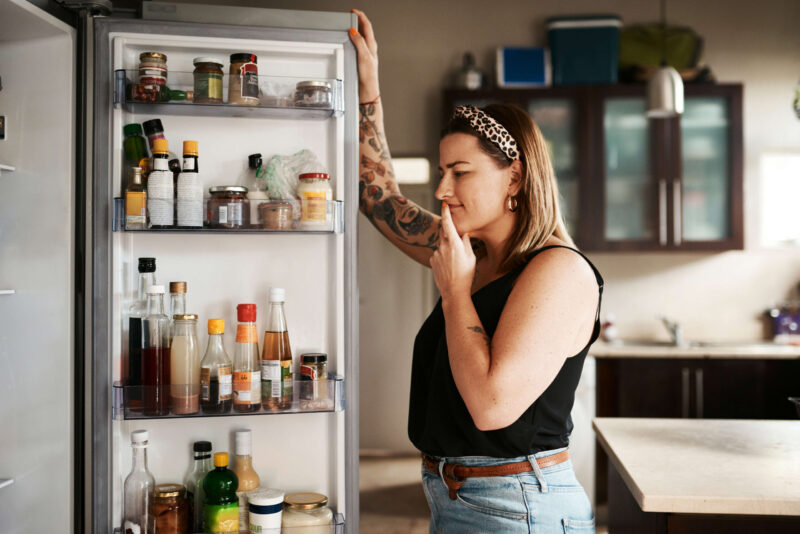
Mastering the culinary craft of barbecue means knowing more than just the perfect rub or cook time. It involves understanding how the refrigerator itself functions and utilizing this knowledge to place ribs in the ideal slot for preservation. I’ve found that the coldest and most stable temperatures exist on the bottom shelf, which minimally fluctuates when the fridge door opens and closes.
Adhering to my personal Rib Storage Guidelines, ensure your ribs are stored towards the rear of this lowest shelf. Here they benefit from consistent cold, away from the temperature swings that can feast on freshness and invite spoilage. Your refrigerator’s configuration plays an indispensable role in this Strategic Fridge Organization strategy:
- Keep your ribs at a safe distance from ready-to-eat foods to prevent any form of cross-contamination.
- Stack labeled, airtight containers in a manner that preserves space while ensuring easy access.
- Always be mindful of expiration dates — rotate older stock to the front, ensuring nothing gets lost in the chill.
With these tips in your apron pocket, you’re well on your way to ensuring that your ribs, whether spared for later or for a leftovers encore, will remain just as tantalizing as when they first captured your taste buds.
Conclusion
In closing, understanding the importance of best practices in rib storage is key to preserving both raw and cooked ribs. Following USDA guidelines, refrigerating within safe time frames, proper wrapping, and maintaining temperatures below 40°F are crucial.
These practices safeguard against spoilage and maintain the quality of our meats. Assessing freshness before consumption and mastering freezing techniques extend the shelf life without compromising flavor. Embracing these tips ensures food safety and optimal taste, enhancing our barbecue experiences.
FAQ
How long can raw ribs last in the fridge?
According to the USDA, raw pork ribs should be cooked or frozen within three to five days of purchase when stored properly in the refrigerator.
What is the best way to store cooked ribs in the fridge to ensure they last?
Cooked ribs should be stored in shallow, airtight containers or tightly wrapped in aluminum foil or plastic wrap. They can last for up to four days in the fridge when stored below 40°F.
Can you freeze ribs to extend their shelf life?
Yes, freezing is an effective way to extend the shelf life of ribs. Raw ribs maintain high quality for about six months, and cooked ribs for up to three months, when stored in a freezer set to 0°F.
What are the optimal fridge conditions for rib preservation?
The ideal refrigerator temperature for rib storage is below 40°F. Ribs should be properly sealed and stored on lower shelves, away from the fridge door to minimize temperature fluctuation and the risk of cross-contamination.
How do you properly store raw ribs in the fridge?
Store raw ribs in their original vacuum-sealed packaging if possible or wrap them securely in airtight containers or bags. Place them on the lower shelves of the fridge and consume them within 3-5 days for best freshness.
Is it necessary to refrigerate cooked ribs within a certain time frame?
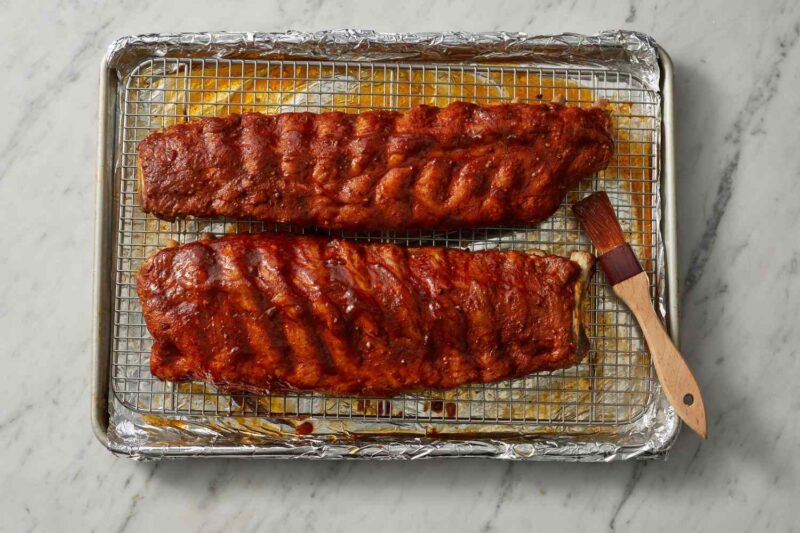
Yes, cooked ribs should be refrigerated within two hours of cooking to prevent bacterial growth. Follow proper storage practices to maintain their quality.
How should you wrap ribs for freezing?
For freezing raw ribs, use heavy-duty aluminum foil, freezer paper, or heavy-duty freezer bags to prevent freezer burn. For cooked ribs, double-wrap in aluminum foil or vacuum-seal them before freezing.
What is the proper way to thaw frozen ribs?
Thaw frozen ribs by transferring them to the refrigerator a day before you plan to cook them. Avoid thawing at room temperature. For quicker thawing, use cold water or a microwave, and cook them immediately after.
How can you tell if ribs have gone bad?
Spoiled ribs may show signs of color changes to greenish-gray or brown, have a sour or ammonia-like odor, or become slimy or mushy to touch. Discard any ribs that exhibit these spoilage indicators.
What should you consider when selecting containers for rib storage?
Choose airtight containers or employ vacuum-sealing techniques to protect ribs from air exposure, which can affect freshness and lead to freezer burn when freezing.
How does strategic fridge organization affect rib storage?
By organizing your fridge space, keeping ribs on the bottom shelf, and ensuring they are away from the door, you can minimize cross-contamination risks and enable a more consistent temperature, which helps in maintaining rib freshness.

